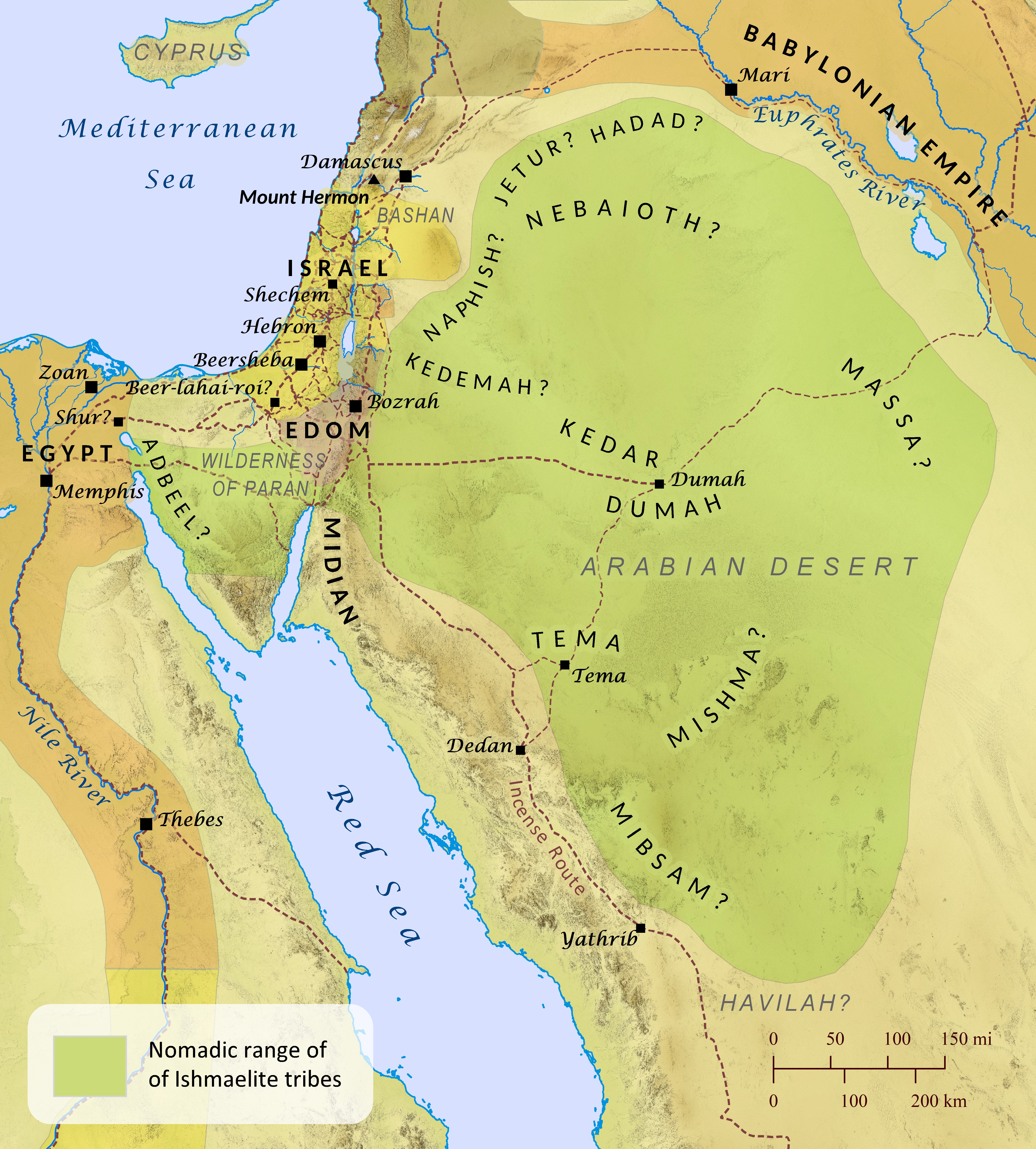BMM BibleMapper.com Maps:

Genesis 21:1-21; 25:1-18; 1 Chronicles 5:3-22
The book of Genesis twice records the origin of the Ishmaelites, who were descended from Ishmael, the son of Abraham by Sarah’s handmaiden Hagar. Ishmael lived in the wilderness of Paran (Genesis 21:20-21), and his descendants eventually ranged from Shur near Egypt all the way around to Havilah on the Arabian peninsula (Genesis 25:12-18), as shown on this map that depicts the region around the time of the Judges. Yet the term Ishmaelite also appears to have referred in a more general sense to any of the nomadic groups that roamed the deserts of Sinai and Arabia, because the Midianites (another group descended from Abraham by his second wife Keturah; Genesis 25:1-2) are twice referred to as Ishmaelites: once when Joseph is sold to a group of Midianite traders traveling from Gilead to Egypt (Genesis 37:28-36), and again when Gideon is collecting gold earrings from the spoil taken from the Midianites (Judges 8:24). Likewise, the term Hagrites, (likely meaning those descended from Hagar), is applied at times to a tribal group that appears to have been among those descended from Ishmael, but in 1 Chronicles 27:30 the terms Ishmaelite and Hagrite are applied to two different people, indicating that the terms were not synonymous. Twelve tribes are specifically listed by Genesis as descending from Ishmael, similar to how Israel was reckoned as being comprised of twelve tribes descended from a single patriarch (Genesis 35:23-26). While some of the Ishmaelite tribes achieved political dominance during certain periods of biblical history, the twelve tribes never operated as a single, unified nation. The physical boundaries of each Ishmaelite tribe’s nomadic range is difficult to establish with much certainty, partially because nomads, by definition, continually move to new lands as needed to feed their flocks. Even so, a few clues from Scripture and other ancient sources point to the likely general range for each tribe, as shown on this map.
Nebaioth has often been speculated to be the same tribe that was later called the Nabateans, but the variance in the Hebrew spelling between the two names makes this identification unlikely. Rather, they were probably the Nabaiate of Assyrian documents, which mention them in close association with the tribe of Kedar. Nebaioth and Kedar are also mentioned together in Isaiah 60:7.
Kedar, the most prominent and powerful of the Ishmaelite tribes, lay to the southeast of Israel, and this is confirmed by Jeremiah’s comment in Jeremiah 2:10 that speaks of Cyprus and Kedar as lying on opposite sides of Israel. Kedar attained significant political strength during the ninth century B.C. until they were absorbed into the Nabatean empire in the first century B.C.
Adbeel was likely a tribe known by the Akkadians as the Idibilu, who were eventually conquered by Tiglath-pileser III of Assyria and employed to guard the approaches to Egypt’s borders.
Mibsam may be named after the word for “sweet odor,” suggesting that they may have been one of the people groups of western Arabia who produced world-renowned incense and transported it to ports along the eastern Mediterranean Sea.
Mishma may have been centered around a mountain called Jebel Mishma today.
Dumah was likely centered around the ancient Arabian city by the same name.
Massa was known to the Assyrians as Mas’a, and they were forced to pay tribute to Tiglath-pileser III. Ptolemy knew the tribe as the Masanoi and located them to the northeast of Dumah.
Hadad is somewhat unknown in ancient sources, although today there is an Arabian tribe named Hadad that are mostly Christians, and they are located throughout the Levant.
Tema was no doubt centered around the city by the same name, and it was located near the rival oasis of Dedan. King Nabonidus of Babylon made Tema his headquarters as he gained control over the other Arabian desert oases (see Jeremiah 49:28; also see “Oases of the Arabian Desert” map).
Jetur was likely located northeast of Gilead, because 1 Chronicles 5:18-22 records how the Reubenites, the Gadites, and the half-tribe of Manasseh attacked Jetur and the tribe of Naphish, captured many of them and their livestock, and occupied their territory until the time of the exile. By the time of Jesus, this tribe was known as the Itureans and had captured land just north of Israel.
Naphish was likely located just east of Gilead, because the Reubenites, the Gadites, and the half-tribe of Manasseh attacked them and the tribe of Jetur and occupied their territory until the time of the exile (1 Chronicles 5:18-22).
Kedemah may have been located near the Reubenite town of Kedemoth.
Though Scripture sometimes refers to various tribes of Ishmael as enemies of Israel (1 Chronicles 5:18-22; Psalm 83:5-8), Isaiah also prophesied to Israel of a glorious day coming when “all the flocks of Kedar shall be gathered to you, the rams of Nebaioth shall minister to you; they shall be acceptable on my altar, and I will glorify my glorious house” (Isaiah 60:7).

